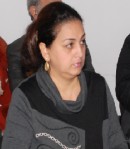
Plenary Lecture
Obtaining Of Perfect Cd1-XMnXTe Epitaxial Thin Films And Their Use Potentials

Associate Professor Matanat Mehrabova
International Ecoenergy Academy
Institute of Radiation Problems
Head of the Department
Azerbaijan National Academy of Sciences
Azerbaijan
E-mail: metanet-mehrabova@rambler.ru
Abstract: In this work the obtaining of Cd1-xMnxTe (x=0.01) epitaxial thin films has been investigated. Cd1-xMnxTe (x=0.01) epitaxial thin films has been grown on freshly broken and polished substrates of BaF2 in a vacuum 10-7Pa in УВН-71 П3 vacuum assembly by the molecular beam condensation method. In the present report are given investigation results of obtaining of Cd1-xMnxTe (x=0.01) epitaxial thin films, their crystal structure, surface morphology, physical properties and use potentials in ionizing radiation detecting, solar cells, optical isolators and etc.
Brief Biography of the Speaker: M. Mehrabova graduated from the Department of Physics on the speciality “Physics of Solid States” of Baku State University, Azerbaijan in 1986. At the end of 1980s she worked in the Institute of Space Researches as an engineer and was post graduate student (1988-1991). In 1992 she got degree of Ph.D in physics-mathematics, in 2011 associate professor and then professor of International Ecoenergy Academy.Now she work in the Institute of Radiation problems as a head of “International projects and Information Department” and head of the “Radiation physics of nanosized semiconductor materials” qroup.
Her scientific activity includes Physics of Solid States, Physics of Semiconductors, Radiative study of Materials, Radioecology, Biophysics and so on.
M. Mehrabova first calculated the energy spectrum and the electron wave function for Pb1-xMnxTe and Cd1-xMnxTe SMS and their size-quantized thin films and studied Faraday effect on the base of the obtained results. She studied theoretically the processes of generation of local levels in the electronic structure of A3B6 lamellar crystals under the effect of ionizing radiation and their elimination. In order to provide the effectiveness of operating mode of the photodetectors made on the base of those semiconductors she studied the problems of selecting optimal values of their parameters taking into consideration their photoelectrical properties. She calculated the threshold energy, bias energy, the cross-section of electron scattering and the number of primary defects during radiation effect on those semiconductors. She is author of about 80 papers published in international journals and conference proceedings.
She study the influence of ionizing and non-ionizing radiation on animals, plants, human-beings and crystals. She works on the problem of making radiation- and photodetectors. She works in some projects which deal with ecology problems.
M. Mehrabova was the winner of the International Project of “Young Scientists of Azerbaijan” in 2003 and was awarded by International Diploma of “Young Scientists of XXI century”. She received STCU certificate of chief specialist on technology commercialization in 2008. Her materials on innovative technologies of IRP ANAS were printed in International Journals such as “Materials and Coatings for Extreme Environments”, “Science Opportunities in Azerbaijan” published on the initiative of STCU in 2009.
M. Mehrabova is the member of “Technology Transfer Center” of ANAS.